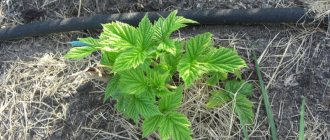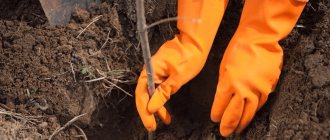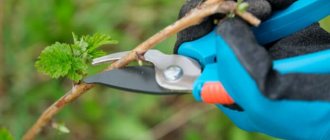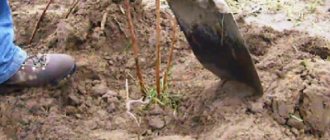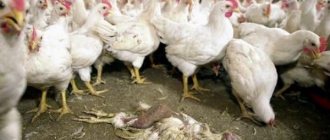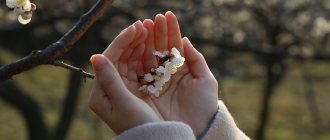Stem gall midge
Gall midge is the formation of new growths on young shoots.
The growth is parasitized by small organisms that poison the shoot and lead to its death. The larvae themselves are almost invisible to the naked eye, their size is only 1-2 millimeters. In spring, the growth cracks, and small mosquitoes form from it, which continue laying eggs on neighboring branches. Insects tolerate winter well and do not die out. The defeat of gall midges in the initial stages may be invisible, but with the onset of August the growths already become visible. The only sure way to combat the parasite is to trim the visible growth. The entire growth is cut off from the shoot, and the cut site is filled with garden varnish. Instead of pitch, you can use hydrogen peroxide, clay, or oil paint. Even the affected shoot, from which the growth has been cut, continues to grow and bear fruit. Stem gall midge is not considered a dangerous disease; it is easily cured and does not cause consequences.
May beetle: how to fight?
In the garden
What to do if the cockchafer is infested in the garden? First of all, deciduous trees (birch, sea buckthorn, plum, apple, cherry) and bushes (strawberries, lilacs, currants, etc.) will have to be protected from encroachers on the garden.
In the mornings and evenings, beetles gather on vegetation for a meal; most often the weather is calm and cool.
It is during this period that you can check all the trees and bushes, shaking off uninvited guests to the ground.
Use, when beetle activity is practically zero, wide sheets of film and long poles for more convenient collection of pests. The insects found can be used as fish bait or poultry feed. Otherwise, it is better to trample or burn them.
Scientists' observations have shown that an average family of starlings is capable of catching about 6-8 thousand adults and larvae of cockchafers in just one nesting period. Attracting such allies will significantly facilitate the fight not only against Khrushchev, but also other harmful insects.
How to fight the cockchafer in the garden? There are plants whose aroma or substances secreted by stems and roots cause persistent hostility in insects. For chafers, these include mustard, marigolds, beans, turnips, elderberries, lupines, white clover and various varieties of cabbage.
If you plant any of these plants in the garden near trees or bushes that are attractive to the pest, then the cockchafer is unlikely to settle in your area.
To prevent beetles from laying eggs in your garden, place various obstacles on the ground. These can be walnut shells, hard tree bark, eggshells, shavings or straw. Thanks to such a protective layer of mulch, the beetles will not be able to easily and quickly penetrate underground, and will most likely go in search of better places for future offspring.
From folk remedies, onion solution can help, which is periodically watered on the soil in places where pests appear. You will need up to 1/3 of onion skins per bucket of water. The solution will be ready for use after 4-5 days. Then it can be diluted again with water. It is not necessary to water the plants themselves with the solution - just the soil.
In strawberry
How to get rid of the cockchafer on strawberries? Especially to repel the cockchafer, plantings of berries such as strawberries, raspberries and strawberries are prepared and sprayed with various solutions.
For 10 l. of water you will need to dilute 1-3 tablespoons of ammonia or 15 drops of iodine per 10 liters.
It is optimal to spray garden bushes 2-3 times at intervals of a week. The weather should be warm and not rainy.
Harmful insects on raspberries
Many gardeners grow raspberries on their property; usually several types of plants are grown at once. No matter what varieties grow, pests will still find something to profit from. Many beetles eat raspberries; most often, certain species can be found on raspberry bushes.
Raspberry beetle
White insects on raspberries with a dark head are nothing more than the larva of the raspberry beetle. Larvae appear in early summer from eggs laid by adults. They do a lot of harm; their diet consists immediately of leaves, and then of buds and fruits. It is the raspberry beetle larva that is one of the main culprits in reducing the yield; it simply eats away the flower from the inside.
Adults are no less dangerous; a larva that has overwintered in the ground appears with the first rays of sunlight in the form of a beetle:
- small size, up to 4 mm;
- the body is oval, slightly elongated;
- color gray.
Raspberry stem fly
The insect itself is harmless to the bush, but the deposited larvae can cause a lot of trouble. The insect lays eggs in May-June, and the hatched larvae begin to destroy young shoots. Starting from the axils of young leaves, the young growth gradually moves along annual branches, gnawing entire tunnels there. After this, more than 80% of the affected branches die, and with them the crop.
You can recognize a raspberry fly by the following external signs:
- small insect size;
- body color is grayish;
- there are two pairs of wings;
- loves to relax on raspberry bushes.
You can fight the insect and its larvae in different ways. They are treated with Bordeaux mixture, Iskra, Confidor, Fitoverm.
Raspberry beetle and raspberry stem fly
Raspberry bud moth
Red beetles on raspberries are quite voracious; they eat out the bud and penetrate inside the stem, destroying the raspberry tree almost completely. This pest is the larva of the kidney moth, which raises its offspring in this way.
The insect has this appearance:
- small butterfly;
- wings dark with light spots;
- the body is slightly oval, elongated.
Stem gall midge
The appearance of this pest can be recognized by the characteristic swellings under the bark of annual raspberry shoots. There is no doubt that this is where the cluster of orange caterpillars, which have hatched from the laid eggs as adults, will be located.
Small brown bugs are very fond of raspberry bushes; just during the flowering period, it is time to lay eggs, from which the pest will develop in the future.
Strawberry-raspberry weevil
Black bugs harm not only raspberries; weevils can ruin crops and other garden favorites. The main problem is the eggs laid directly into the bud, from which small caterpillars hatch. They devour the brushes, and from mid-summer they become full-fledged adult beetles and switch to raspberry leaves and stems.
Spider mite
These green beetles weave thin webs from the back of the leaf, which then dry out, sometimes this can kill many plants. The control methods used for spider mites are identical to the preventive ones for the vineyard.
A photo of the raspberry beetle will help you decide on the name; then the gardener himself will decide how best to combat the pest on his site.
Raspberry pests
Which raspberry pests are the most dangerous?
No matter what variety of raspberries grow on your site, diseases and pests can ruin a good part of the harvest or even destroy the plant itself. Agree, it’s not pleasant when every now and then you come across berries spoiled by beetles and wormy, and the shoots wither before they have time to bear a harvest. To protect raspberry bushes, you need to take preventive measures and promptly destroy emerging insects.
Raspberries in the photo
Here is a list of the most undesirable insects for raspberry plants:
- Raspberry beetle - adults have a gray oval body up to 4 mm long; the larvae have a brown head and a light body. After wintering in the ground, the beetles emerge in mid-May and first eat the flowers of bushes and weeds, and then move on to raspberry buds, completely eating them away from the inside. Even more harmful are the larvae that emerge from eggs laid by raspberry beetles on young leaves, ovaries and flowers. The result is a noticeable reduction in yield and wormy berries.
- The raspberry stem fly is a gray small fly that appears in May-June and lays eggs in the axils of raspberry leaves, as well as on the tops of young stems. The danger comes from the larvae, which make passages in young shoots, causing blackening and drying of up to 80% of the stems.
- The raspberry bud moth is a small dark moth with light spots that produces red larvae with a dark head. The larvae eat the contents of the swelling buds and penetrate inside the stems, pupating there. Adult butterflies lay eggs in raspberry flowers, and the emerging caterpillars, eating the fruit, descend down the shoots, where they remain overwintering in cracks in the bark. Thus, the bud moth damages the buds, berries and stems.
Pictured is a raspberry stem fly
- The stem gall midge is a brown mosquito about 2 mm in size with small transparent wings. During raspberry flowering, this pest lays eggs in the lower part of annual stems, and the newly born light orange caterpillars penetrate inside the shoots, causing characteristic swellings under the bark.
- Spider mites are tiny pests whose thin webs can be seen on the underside of raspberry leaves (one of the pests of grapes). Severely damaged leaves dry out and fall off.
- The strawberry-raspberry weevil is a dark gray beetle no larger than 3 mm in size. It harms raspberries by laying eggs in the buds. White larvae with a yellow head eat the buds from the inside, and by mid-July the larvae turn into beetles and begin to damage the raspberry leaves.
Video about raspberry pests
On the Internet you can easily find what all the listed raspberry pests look like in pictures. You should know your “enemies” by sight! Having learned to identify insects that are dangerous to raspberries by appearance, you will know how to deal with them in the most effective way.
Processing raspberries as a means of preventing worms in berries
The worm spoils ripe raspberries. To protect raspberry bushes from worms, it is necessary to carry out preventive measures. A way to treat raspberries in the spring against worms:
- In early spring, the bushes are watered with hot water (80 degrees). It is recommended to douse bushes and soil;
- In the fall, the area with raspberries must be dug up, the remaining weeds must be removed, and the soil must be mulched. Humus, peat, sawdust, and compost are used as mulching materials. Worms living on the soil surface cannot get out from under the mulch layer;
- During the flowering period, worms can be collected by hand. The surest way to quickly remove worms from raspberries and clean all the bushes is to spread the film on the ground and shake the raspberry bushes. Carefully collect and burn fallen worms;
- A popular way to treat raspberries for worms in the berries: the bushes are sprayed with a soda solution (10 g soda plus 5 liters of water) or mustard infusion.
Pests can cause serious damage to a gardener. They can damage raspberry bushes and ruin the harvest
Therefore, it is important to carefully inspect the bushes in spring and summer and promptly destroy them when insects appear. Knowing how to get rid of worms in raspberries, weevils, flies, and bedbugs, you can grow a large harvest of aromatic, delicious berries
Control measures
Knowing the development cycle of this insect, it is easy to prevent its subsequent reproduction and protect the raspberry crop from damage. In this matter, timely agrotechnical techniques, delicate folk remedies, lethal chemicals and gentle biological products come to the rescue.
Agrotechnical techniques
Before you go on the warpath with the raspberry beetle, take a look at your raspberry bed - is it too thick? Since autumn and spring digging of soil between the rows of the berry garden, as well as regular loosening of the soil around the bushes can significantly reduce the number of pupated larvae and young beetles, take care of the convenience of carrying out such procedures and first thin out the raspberry plantings.
Raspberry stem fly (Chortophila dentiens Pand)
A small (up to 7 mm long) flying insect of a brownish-gray color with transparent wings. It damages raspberries and blackberries in May (depending on the ambient temperature) during the period of shoot growth. The female lays eggs in the axils of young shoots, which leads (as the larva develops) to the necrosis of tissue above the area where the eggs are laid. The larvae gnaw through the stem and rush to the base of the shoots. The stems turn black, dry out, and bluish rings appear around the passages. The larvae move to the base of the stem, after which they settle there for the winter.
In the spring, after the soil warms up to 13-15°C, raspberry flies fly to the surface, and the cycle repeats. Often weakened and rotten shoots mislead gardeners, who mistake this for isolated cases of disease or damage. The main thing is to have time to cut off and burn the wilted tops of the shoots just below the egg laying site in order to prevent the larva from going inside the stem for the winter. But this measure is relevant only until the larvae hatch from the eggs.
Measures to combat raspberry stem fly:
|
Most raspberry pests are very difficult to detect due to the fact that they are small and hide in shoots and stems. Therefore, be careful, do not neglect the garden and remember that only timely prevention and treatment will help get rid of garden scourges.
Raspberries: pests
jjjjjjjjjjjjjjjjjjjjjjjjjjjjjj
Like all other fruit and berry bushes, pests cause serious, sometimes irreparable damage to raspberries.
Unfortunately, not everyone has an idea of how to treat raspberries against pests, and what measures need to be taken to prevent the spread of insects throughout the garden.
As a result, not only these plants, but also other crops wither. For example, many pests of garden raspberries can move to blackberries, and some to strawberries.
Protecting raspberries from gall midge and stem fly pests
Gall midge and stem fly are the main pests of raspberries
Raspberry galitz is an insect that reaches a length of 1.6-2.2 mm and is black in color. The back of the pest is brown, covered with light yellow hairs. In addition, the insect has transparent wings.
Gall midges damage not only raspberries, but also blackberries. The greatest harm is caused by the larvae of these insects, since, having climbed under the bark of the plant, they contribute to the formation of galls, in which they remain to overwinter. To protect raspberries from these pests, damaged shoots must be burned in early spring or autumn.
The raspberry stem fly is a small insect (up to 5 mm) gray in color.
Overwintering of fly pupae takes place in cocoons in the upper layers of soil under raspberry bushes.
In mid-May, when the period of regrowth of young raspberry shoots begins, flies appear.
These raspberry pests lay eggs in the axils of the apical leaves.
After some time, larvae appear, penetrate the stem and gnaw out a spiral-shaped passage in it to the base of the shoot.
The tops of damaged shoots wither, then turn black and rot. During the flowering period of raspberries, fly larvae leave the stems and hibernate in the soil.
To combat raspberry stem fly, it is recommended to regularly inspect raspberry bushes, and if a pest is detected, immediately cut off the tops of the shoots before the fly larvae have yet moved to the base of the stem. If a hole made by the larva is noticeable inside the cut shoot, then the shoot should be cut even lower.
In late autumn, it is necessary to dig up and loosen the soil under the raspberry bushes, promptly rake and remove fallen leaves.
Treating raspberries against the weevil pest
The insect damages not only raspberries, but also strawberries and strawberries: females lay eggs directly into unopened buds, gnawing the peduncle. Therefore, in old beds there are often bushes with “cut off” pedicels.
After some time, larvae appear and gnaw the contents of the buds. The larva pupates while in the flower. Beetles overwinter in the soil, under fallen leaves.
Measures to combat the raspberry beetle are as follows : it is necessary to spray the bushes with infusions of tansy, hot pepper and wormwood. Treatment is carried out during the budding period.
In addition, autumn digging of the soil, as well as burning dry leaves and tops with beetles remaining over the winter, are effective. In the fall, it is necessary to dig up the soil under the bushes and loosen it. In the morning, you can shake off the pest onto a cloth or newspaper spread under the crops.
It should be noted that it is not advisable to grow raspberries and strawberries next to each other, since these plants have a common pest.
In the city of Enterprise (USA), a monument to the weevil beetle was erected. In 1915, this pest destroyed all cotton crops, leaving Alabama farmers on the verge of ruin. For a long time, cotton was the main crop here.
The harvests were so good and abundant that the farmers did not even think about growing other plants. However, the invasion of the pest forced farmers to turn their attention to those crops that the weevil does not damage.
As a result, farmers developed a diversified economy. Potatoes, sugar cane and peanuts began to bring them significant income. Thanks to this, the destroyed economy was restored, and considerable benefits were obtained.
Thus, the Weevil Monument, erected in 1919 by the residents of Enterprise as a sign of gratitude to this insect, can still be admired to this day.
You can scare away the raspberry-strawberry weevil by planting onions or garlic between the beds of strawberries. In addition, you can treat plants with an infusion of garlic arrows. When treating raspberries against these pests, you can spray the plants with a solution of potassium permanganate (5 g per 10 liters of water). Treatment should be carried out early in the morning or in the evening after sunset.
Pest control of raspberry glass
The raspberry glass is a butterfly whose wingspan reaches 3 cm. Its body is black and blue, with yellowish transverse stripes on its abdomen. The wings are transparent.
In June-July the butterfly season begins. At this time, they lay eggs on the surface of the soil near the base of the raspberry stems. A female glassfish can lay up to 200 eggs.
White caterpillars emerging from eggs begin to bite into the stems and roots of raspberry bushes, which leads to the formation of swellings on them.
Overwintering and pupation of caterpillars take place in the core of stems or roots.
By July of the next season, the caterpillars turn into butterflies and emerge to the surface.
Raspberry shoots affected by glassware wither and then dry out.
To combat glassware, it is recommended to regularly inspect raspberry shoots.
If mechanical damage to the bark is detected, such branches should be removed. Old shoots must be cut out immediately without stumps.
Treatment of raspberries in spring against the raspberry beetle pest
This pest belongs to the raspberry beetle species. The body length of adult insects reaches 3.5-4 mm. It is grayish-black in color, maybe with a reddish tint; the apex of the abdomen and the edges of the pronotum are in most cases reddish.
The beetles climb into the flowers and ovaries of common raspberries, gnawing them out. In addition, the raspberry beetle also damages the buds and leaves of the plant, which dry out after a short time.
Larvae develop inside the berries. These are yellow-white caterpillars with transverse brown stripes on the back. At the end of raspberry fruiting, when most of the berries are damaged, the larvae fall to the ground.
They overwinter in the soil until the spring of next year.
Many gardeners are interested in how to treat raspberries against pests in the spring, when they have not yet begun to bloom. As soon as the snow melts, in early spring, raspberries are treated against this pest using infusions of insecticidal plants.
Manual collection of beetles during raspberry budding is effective. Mandatory preventive measures in the fight against the pest are digging up the soil in autumn and destroying the larvae after removing them from damaged berries.
Subscribe to receive articles
Enter your email
Source: https://cluboz-praktik.kiev.ua/encyclopaedia/vrediteliMaliny
Raspberry glass
The main sign of infection of raspberry plants for parents such as raspberry glass is the formation of characteristic swellings on the shoots. In addition, in the area you can see a blue-black butterfly, resembling a wasp in appearance, with bright yellow stripes on its belly. However, it is not butterflies that damage plants.
The damage is caused by their larvae - white caterpillars with a brownish head. The eggs are laid by the female near the base of the shoots, and some time later the caterpillars emerge from them and, crawling under the bark, make spiral-shaped wormholes in it.
The larvae penetrate inside the shoot and remain there to overwinter. A thickening appears in this place. After wintering, the caterpillar moves inside the stem, gnaws a hole at the base, and then pupates. The butterfly flies out of the hole after the raspberries bloom and lays eggs again. Shoots damaged by glass cells stop bearing fruit, wither, become brittle and dry out quickly.
The fight against glassware is:
- removing shoots that have borne fruit;
- cutting off affected bushes almost to the root and then burning them;
- periodically loosening the soil around each bush;
- thorough inspection of planting material;
- treatment of raspberries against glass glass pests with Karbofos. Spraying is carried out before the first leaves appear and before flowering begins.
Raspberry beetle. Mission: recognize and destroy
Oh, how sweet, aromatic raspberries beckon! We still need to find those indifferent to this summer delicacy! And there certainly isn’t a single summer resident who doesn’t have such an unpretentious and productive berry plant growing on his plot.
Raspberry is a delicious berry
We are all looking forward to midsummer so we can quickly taste the amazing taste of this berry. But when the long-awaited moment of harvest arrives, some people receive raspberries with a surprise - they find disgusting yellowish worms in them. Instead of pleasure - disappointment, and then bewilderment and irritation! How to call this nimble enemy, who managed to “bite” the berries, and most importantly, how to rid the plantings of his invasion?
Raspberry beetle larva
Protecting raspberries from pests: spring work
Most gardeners associate the retreat of winter cold and the beginning of snow melting with the beginning of the home gardening season.
When the threat of return frosts has passed and the sun's activity increases, it's time to worry about the health of berry bushes, including currants and raspberries.
It is more practical to cultivate raspberry bushes immediately after loosening the soil and applying organic fertilizers.
To prevent the spread of infections carried by raspberry pests, the root zone of plants is mulched with rotted manure. The bacteriological environment suppresses a number of viruses and spores that are dangerous to berry bushes.
Universal means for preventive spraying include broad-spectrum insecticides:
If you treat your plantings with these preparations twice a year, in spring and autumn, you will not encounter the problem of a large number of pests attacking raspberries throughout the entire season.
In the case where attacks by certain types of insects have already been noted on your garden plot, you should additionally treat the bushes with highly specialized means:
Aphid repellent
Small pests are incredibly voracious and multiply very quickly
Therefore, during the period when the first leaves appear, it is important to additionally treat the bushes a second time with a standard set of preparations: As a rule, pests overwinter in soil or plant debris and attack weakened plants
As a rule, pests overwinter in soil or plant debris and attack weakened plants.
Spring treatment is combined with cleaning the root zone of fallen leaves and sanitary pruning of shrubs.
Prevention
To limit the spread of raspberry beetle pests, it is recommended to use the following preventive measures:
It is not recommended to plant raspberries next to apple and pear trees. The beetle flies out in early spring, at which time it feeds on the flowers of fruit trees. Apple and pear trees bloom in early spring, and it is on them that the raspberry beetle rushes after spending the night. If raspberries are placed next to flowering trees, the risk of fruit damage increases greatly. Regularly feed plants with organic fertilizers. Be sure to add ash solution to the soil. It is recommended to use an ash solution for treating shrubs by spraying. In early spring, before flowering, it is useful to spray raspberries with a 1% solution of Bordeaux mixture. It is useful to carry out deep plowing of the soil in the spring. The procedure will help destroy insect burrows and destroy them. Organize regular watering for crops. Do not allow the soil to dry out or become waterlogged. Be sure to thin out the raspberries every year. It is necessary to trim overgrown branches and bushes to ensure air flow to the plants. After harvesting, be sure to dig up the soil near the raspberry tree. It is first recommended to sprinkle a thick layer of tobacco dust on the surface of the soil, then dig the ground deeply. This procedure will help bring insects hidden for the winter to the surface.
Tobacco dust that gets into deep soil layers will serve as an additional prevention of the spread of the pest. It is important to carry out regular inspection of shrubs. If larvae or adults are found, it is necessary to urgently get rid of them
It is advisable to best inspect plants in the early morning; at this moment, insects are in a passive state, so they are easy to detect and collect.
Spray raspberries with insecticides and biological products
Features and symptoms Description: raspberry beetle (Byturus tomentosus) is the main culprit of crop loss; this insect is up to 6 mm long and has a gray-red hue; causes serious harm, especially to numerous offspring - larvae during mass reproduction can completely eat the crop; beetles on raspberries wake up at the end of April or beginning of May, when the soil warms up to +10 °C; The larvae feed on young foliage of weeds; when they mature, they move to raspberry bushes, where they lay their eggs
Ways to fight
')); (w||(w=[]))&&w.push({id:b,block:'14502'});})(window,document,"mtzBlocks");
Description: use insecticides against the raspberry beetle (Karbofos, Iskra, Kinmiks), and chemical treatments must be repeated at least twice; Additionally, treatment with biological products “Guapsin” and “Bitoxibaccillin” should be carried out; use any preparations only before the formation of buds; after this, you should cover the raspberry tree with lutrasil or a fine-mesh material (for example, gauze) so that the pest does not penetrate; it is important to regularly loosen the soil around the bushes, adding a little tobacco dust to the soil, which will repel insects; After the formation of buds, use only folk remedies that are safe for berries for spraying
Prevention Description: in autumn and spring, the soil should be thoroughly loosened, which will destroy pupae overwintering in the soil; in April, after loosening, cover the ground with a thick layer of mulch - this will prevent the remaining pupae from crawling out; it is necessary to regularly trim excess shoots, shoots, and thin out bushes to ensure maximum air circulation; you should not plant raspberries near apple and pear trees, since the raspberry beetle attacks these fruit trees; regularly add ash and organic fertilizers to the soil
Butterfly class
This class contains a variety of raspberry pests that look like butterflies.
The first representative of the class is the noctuid. There are two types:
Raspberry golden - there are bright yellow wings with gray-brown spots on them. The caterpillars live on raspberries and blackberries and feed on their leaves.
The gray ground caterpillar is twice the size of this butterfly. It feeds on raspberry leaves from late May until autumn.
How to fight? If there are holes in the raspberry leaves in the garden, there is no better method than treating them with an insecticide.
The second pest butterfly is the raspberry glasswing. It looks like a wasp: the body is blue-black, with yellow circles, the wings are transparent. The insect lays eggs in the soil near the raspberry shoot.
If there is insufficient movement of juices in the stems, the yield decreases, the shoots grow poorly and become brittle.
Another butterfly that harms raspberries is the raspberry bud moth. It is brown in color and has yellow spots on its wings.
It is the moth larvae that are dangerous, not the adults. After all, only a larva can bite into a bud before flowering and completely destroy it, and then pupate in the stem. During raspberry flowering, the butterfly lays eggs in the receptacle. The emerging caterpillars are voracious. They eat the fruit and move down the stem to the shoots, where they overwinter, making a cocoon.
From the end of May to September, leaf rollers also attack raspberries. This is also a brown, brown or yellow butterfly. The leaf roller caterpillar infects the leaves. She weaves a web around the leaves so that they curl. It can cause harm during the flowering period to buds, buds, and, as a result, the berry itself.
How to fight? Various types of insecticides are used - chemical ones: Iskra Double Effect, Fufan, Inta-Vir, karbofos emulsions; biological - Actofit, Lepidotsid, Mospilan.
For prevention in the fall, old shoots and growths are removed, and the lower part of the shoots is generously sprayed with chemicals.
Beetle control methods
The fight against this pest combines a number of agrotechnical techniques, as well as preventive and therapeutic treatment of plantings.
We invite you to familiarize yourself with the features of autumn planting raspberries.
Agrotechnical techniques
The fight against raspberry beetles must begin with simple agricultural techniques:
- Perform deep digging of the soil in autumn and spring. Thanks to this, the number of pupae that overwinter in the soil is significantly reduced. At the same time, add wood ash and tobacco dust to the soil.
- In the warm season, sprinkle the soil around the bush with mulch to prevent insects from leaving the soil. Crushed peat, sawdust or humus are suitable for this.
- Before flowering, spread a tarp under the plants and shake off insects from the branches, then destroy them. Carry out the procedure early in the morning, when the beetle is inactive.
- To plant raspberry bushes, choose a place as far as possible from apple and pear trees - raspberry beetles use these plants as additional food.
- Before flowering, the bushes can be covered with gauze or agrofibre - this will protect the plant from the harmful effects of the pest.
- Regularly inspect the plantings, manually collect damaged fruits, and then burn them.
- In early spring, carry out preventive treatment of the soil around the bushes with Bordeaux mixture at a concentration of 2%.
Ground beetles are considered the natural enemies of the raspberry beetle. These are fairly large beetles, usually black in color, and belong to one of the most common families of these insects. To attract ground beetles closer to raspberries, you need to plant garlic or onions next to them.
Biological products
To destroy this pest, the drug “Guapsin” is widely used, which has a very good result in the fight against raspberry beetles - up to 94%.
2% Bitoxibacillin has the same properties. Treatment with biological products should be carried out twice: before the appearance of buds and before the flowers bloom.
Chemicals
Treatment with insecticidal agents is carried out twice a year: before and after flowering.
The following drugs are used for this:
- “Iskra” is a tablet product that is dissolved in water at the rate of 1 tablet per 10 liters of liquid.
- "Karbofos" - it is used when a large number of beetles are detected. 90 g of the active substance must be diluted in 10 liters of water.
- “Kinmiks” or “Confidor” are emulsions prepared according to the included instructions. To treat 1 bush you need 1.5 liters of working solution.
- “Fufanon” at a concentration of 0.1% is recommended for high degrees of damage in the bud formation phase.
Important! When working with any of these chemicals, you must use protective equipment - a respirator and gloves
Traditional methods
In addition to chemicals, there are also a number of folk ways to combat this pest:
- Potassium permanganate solution. An aqueous solution is prepared from this substance: 1 g of active substance is needed per 20 liters of liquid. After the snow has melted, the resulting product is used to treat the soil under the bushes.
- Mustard solution. The plant is treated with it before flowering. To do this, mix 100 g of mustard in a small amount of hot water until it reaches a creamy consistency. Then dilute the resulting mass with another 10 liters of water.
- Tansy infusion. Infuse 700 g of the plant in 1 bucket of water for 24 hours, then bring to a boil and cook for about 30 minutes. Cool the infusion, strain and add another 10 liters of water.
- Tobacco infusion. To obtain it, pour 1 cup of dry substance with 10 cups of water, then leave on fire for 2 hours. Before applying to the soil, dilute with water at a rate of 1:3.
- Soda solution. Before the ovaries appear, the bushes need to be sprayed with this substance. For 10 liters of water you will need 1 tbsp. spoon of powder.
Treatment of plants must be carried out in dry and sunny weather.
In case of rain, the procedure should be repeated. Preventing pest damage to raspberry plantations is quite simple. First of all, it is necessary to comply with all norms of agricultural technology, and also not to forget about preventive treatments of raspberry bushes before and after flowering.
Insecticidal attacks
Chemical control methods are repeated twice. Otherwise, you cannot count on effective plant protection. Popular drugs:
- If the beetle population is large, at the beginning of the appearance of newly formed buds, sprinkle the raspberries with Karbofos (90g per bucket of water).
- 2.5 ml of Kinmiks solution diluted in 10 liters of water. Spraying based on a consumption of 1.5 liters per 10 bushes.
- In case of severe damage, you can use control methods with the following drugs: Fufanon solution (0.1%) in the bud formation phase, “Iskra” (1 tablet dissolved in 10 liters of water) before and after flowering. Fufanon is a stable drug. Its damaging effect lasts for 21-25 days from the date of treatment.
Inta-Vir proves its effectiveness
The list of chemicals can be supplemented with Fosbecid, Inta-Vir, Confidor, Actellik. Prepare chemicals according to the attached instructions. It is economically profitable to use insecticides if, when examining a raspberry bush, 3-4 caterpillars or beetles were found on one bush.
Methods to combat the raspberry beetle:
Spray raspberry bushes with a solution of potassium permanganate at the rate of 0.5 grams of potassium permanganate per 1 bucket of water.
Some gardeners advise making onion and garlic beds near raspberries. These plants repel beetles and attract beneficial insects (ground beetles, hoverflies).
We spray raspberry bushes with fungicides or insecticides when buds appear. The drug “Fitoverm” helps many people very well, it keeps the defense up to three weeks. You can use Fufanon instead. Treatment is carried out at the end of May (when the cherry blossoms).
You can also try using emulsions of the drugs “Confidor”, “Kinmiks” (per 10 liters of water – 1 ampoule of 2.5 milliliters) and “Iskra” (per 10 liters of water – 1 tablet). The last of which can be found in almost any store. The solution consumption is 1-1.5 liters per 10 raspberry bushes.
During the formation of raspberry buds, you can simply shake off the beetles themselves onto special bedding laid out under the bushes on the ground, or simply into an upside-down open umbrella. All collected beetles must be destroyed. It is best to do this at the very beginning of raspberry flowering, early in the morning, at an air temperature of up to +12°C, when the beetles are still sleepy and inactive.
Among herbal remedies, tansy infusion is recommended (350 grams of dried herb per 5 liters of water). Infuse for a day, and then boil for 30 minutes, filter and add cold water, so that you end up with 10 liters of infusion.
Fading shoot tips should be cut off after 1-2 weeks.
In my personal opinion, successful control of the raspberry beetle should be carried out first of all before the raspberries bloom. We spray raspberry bushes with INTA-VIR (1 tablet per 10 liters of water). I was happy with the result, and no extra hassle with “shaking” the bushes.
It is necessary to loosen the soil under raspberry bushes in late autumn or early spring. In the fall, be sure to carry out additional digging of the soil in order to remove excess raspberry branches in addition to beetles. It is recommended to add charcoal or tobacco dust when digging.
By missing the moment of budding, we end up with wormy raspberries. The raspberry beetle does not cause particularly serious damage to the raspberry bushes themselves.
Beetle on a flower
Features of the appearance of beetles on raspberry bushes
In the photo - spraying: a reliable way to prevent the appearance of a pest. Photo: viridarus.ru
- Raspberries are an unpretentious crop . However, it may be subject to pest attack. To avoid this, it is important to provide the plants with proper care. Especially in the spring, when all the insects come out: loosen the soil, remove weeds, trim damaged shoots.
- Preventive treatments will help avoid the appearance of pests and diseases . It is recommended to use safe biological preparations and folk remedies. In case of severe infection, insecticides cannot be avoided, but their use should be stopped a month before picking the berries.
- Pests are carriers of many diseases. That’s why it’s so important to start fighting them immediately after detecting the first signs.
A relative of the raspberry beetle is the raspberry beetle: a beetle that is a pest of raspberries.
Photo: macroid.ru The author of the video talks about the main ways to combat the raspberry beetle. Focuses on preventative treatment that will help cope with various pests:
Raspberry beetle (Byturus tomentosus)
The nasty little wriggling worms that spoil the whole impression of raspberries are the larvae of the raspberry beetle. Both they and adult individuals overwinter at a depth of 5-20 cm and in early spring feed only on nectar and weed pollen. And only then, having gained strength and become stronger, they switch to raspberries, currants and gooseberries.
The raspberry beetle is a small insect (up to 4 mm in length) that feeds on raspberry flowers and lays eggs directly in the berries. As the berries ripen, the larvae themselves grow and feed on the tender and juicy pulp. You can see them only by picking the berry, which makes it much more difficult to detect the pest. The period of beetle activity occurs in June, before the raspberries bloom. If you started processing strawberries earlier, then the beetle will move from them to raspberries somewhere in mid-to-late May.
Each female lays up to 40 eggs directly into the flowers. At the same time, she tries to lay one egg in each ovary in order to provide each larva with a “separate apartment.” If the worms were not detected, then in the fall they leave the fruits for the soil, where either the following spring or a season later they turn into adult beetles.
Measures to combat the raspberry beetle:
|
Traditional methods of struggle: Bordeaux mixture
The specificity of the pest is such that homemade spray compositions that are effective against other insects do not affect the raspberry fly. However, gardeners are constantly looking for their own ways to get rid of this insidious enemy. For example, Oksana Koklyushkina, in a commentary to an article about fighting sawfly on gooseberries, shares her method of how to fight raspberry stem fly. She claims that it is enough to water the soil with Bordeaux mixture in the fall and there will be no problems with pests on raspberry bushes, and there will be no problems on gooseberry bushes either.
Composition for preparing Bordeaux mixture
From our point of view, there is a positive meaning in using this substance, however, simply pouring a liquid solution on the soil is clearly not enough, in our opinion. Most likely, the reader uses some kind of insecticidal preparation for spraying, and additionally treats the soil with the above-mentioned agent.
As a reference. Bordeaux mixture is a mixture of copper sulfate (better known as copper sulfate) with milk of lime. This drug has been used in gardening for a very long time, but primarily in the fight against diseases of trees, shrubs, grapes, and roses. Its effectiveness has been proven in eliminating fruit rot, rust, scab, stem cancer, gray rot, septorhiza, cocomycosis, etc. Bordeaux mixture can also be used against pests, only before flowering at the stage of bud break.
https://youtube.com/watch?v=vMNbzjtiNDU
Check out articles on similar topics
- Proven measures to combat raspberry-strawberry weevil
- How to get rid of raspberry beetle
- How to protect raspberries from pest moths
- What to do if cabbage attacks raspberries
The raspberry beetle is one of those insect pests that love raspberries so much that they specialize in them only. In nature, the raspberry beetle damages forest raspberries, but it will not refuse varietal or garden raspberries. It is difficult to fight the raspberry beetle - only comprehensive measures will save you from the invasion of raspberry beetles.
The raspberry pest damages the leaves and fruits of raspberries throughout the globe, leaving industrial producers, farmers and summer residents with no harvest, because raspberries with worms are equally disliked by children and adults. The larvae of the raspberry beetle look like worms.
The raspberry beetle (English Raspberry beetle, Latin Byturus tomentosus) is a lover of camouflage; its small size and inconspicuous color make it inconspicuous among raspberry thickets, which it takes advantage of by mating and laying eggs on buds, flowers and young raspberry ovaries. The body length of an adult raspberry beetle is about 4 mm. The body is covered with gray or yellow hairs, the elytra are gray and black.
The larvae of the raspberry beetle look like white worms, 5-7 mm long, covered with bristles. It is the larvae that brazenly crawl out of the harvested raspberries, swimming in the water and in the jam. The larvae feed exclusively on ripe berries, so the berries shrivel and lose their presentation.
Having noticed a lot of spoiled berries, you need to pay attention to all the berries collected from the bush - most likely there are larvae in other berries
Adult female raspberry beetle (imago). Photo: NatureSpot
Raspberry beetles begin their activity in the spring, when the soil warms up to +12°C. At this time, adults, adult insects, crawl out of the soil, climb onto young raspberry bushes and begin to intensively feed on young foliage, as well as flowering weeds. Raspberry beetles can fly, so they flutter from bush to bush, from neighbor to neighbor. If there are no raspberries, then the bushes and berries of blackberries, cloudberries, as well as pear, apple and bird cherry trees begin to spoil.
When the sides are fattened, the beetles begin mating and oviposition. Female raspberry beetles lay eggs directly into flowers so that by the time the ovary forms, a week later, caterpillars can hatch from the eggs. One female can spoil up to 40 raspberries by laying one egg per flower.
The activity of the raspberry beetle larvae does not go unnoticed - the berries develop poorly, become deformed, wither and crumble. Within a month and a half, the caterpillars manage to spoil the entire raspberry harvest, and then, having eaten, they fall to the ground and burrow into the ground. They overwinter near the roots, in loose soil at a depth of about 20 cm. The raspberry beetle larvae pupate a year later, in the following July-August.
Raspberry beetle: description
The common raspberry beetle (imago) is an insect with an oval-shaped body and body dimensions from 3.8 to 4.3 mm. The color of the beetle is dark brown or grayish-black, the body is covered with hairs of a yellowish-golden, rusty, sometimes gray hue. The antennae and limbs are brown or yellow. The eggs are elliptical in shape and white. The beetle larvae look like caterpillars with a brown head and a yellow body, which is covered with sparse golden hairs; at the end of the body there are two spines turned upward. The size of the larva ranges from 6 to 6.5 mm.
Raspberry development cycle
Adults or larvae overwinter in the top fertile soil layer at a depth of 5 to 25 centimeters. In the spring (approximately mid-May), when the ground warms up to +12°C, 2 weeks before the raspberry bushes begin to bloom, the beetles crawl to the surface.
At the beginning of spring, adult insects eat young leaves and flowers of other plants (they eat pollen and stamens of cherry, dandelion and early flowering weeds) in order to begin to reproduce.
Feeding on pollen from forage plants accelerates the maturation of female reproductive products by 2 times, compared with a diet consisting only of raspberries.
After about 2 weeks, the pests move to the raspberries and feed on their buds. The raspberry beetle is found on rowan trees, apple trees, currants, pears, gooseberries, plums, blackberries and even bird cherry trees.
The female beetle lays eggs (20 or 30 pieces each) in raspberry flowers, on young ovaries and leaves. The timing of egg laying coincides with the raspberry flowering period.
The larvae that emerge from the eggs after 7–10 days immediately crawl into the berries, eat the drupes, feed on the raspberry fruit, live in the fruit until ripening, causing damage in the form of winding corridors or destroying it completely. After the berries ripen, some pests go into the ground to a depth of 15–20 cm in order to pupate, some remain in the berries until harvest. Later, around August, the pupae turn into overwintering young beetles.
The raspberry beetle has one generation and spreads by migration: the flight distance reaches 120 meters.
The spread of the pest is favored by raspberry cherry trees, apple trees, pears and dandelions growing near the bushes.
Maximum damage to raspberry fruits is observed in wet years; the raspberry beetle is especially active in the European part of Russia. Depending on the growing conditions of raspberries, damage to the crop can range from 10 to 50%; damaged berries become small, wither or rot, take on an ugly shape, and their color fades.
Raspberry beetle - photos and all known methods of destruction
Not only adults and children love raspberries. Various insects are also not averse to feasting on it. The greatest danger among them is the raspberry beetle. In everyday life it is often called raspberry.
Pest settlements in the bushes can lead to the most unpleasant consequences. The plant begins to wither, the beetle larvae make the berries unsuitable for consumption and sale, and significantly reduce the yield.
Preventive measures and the right strategy for exterminating raspberry beetles will help get rid of them once and for all.
Detailed description and photo of the pest
The raspberry beetle is a typical representative of the raspberry family from the order Coleoptera. In accordance with its name, it chooses plantings of garden, ornamental raspberries and blackberries as its habitat. Sources of additional nutrition can be currants, gooseberries, cherries, thorn bushes, pears, and rowan.
Appearance
How to recognize a pest:
- the raspberry beetle is characterized by an oblong oval body, its length ranges from 3.5 to 4.5 mm;
- the color is predominantly dark gray, with red-colored individuals being less common;
- the body is densely covered with hairs of the same color;
- along the edges of the pronotum and abdomen the color is more saturated, most often it is reddish;
- brown or yellow club-shaped antennae and serrated claws.
The eggs are tiny in size, not exceeding 1 mm, capsule-shaped, yellow or white.
The worm-like larva of the raspberry beetle boasts 3 pairs of movable legs, a yellowish color and sparse fibers on the body. Each segment is decorated with dark spots. The maximum length of a young individual is 6.5 mm.
On a note! A characteristic feature of the larvae is the presence of two hook-shaped spines on the last segment of the body, which are curved upward.
Features of life
Adults and larvae spend the winter in the surface layers of the soil at a depth of 5-20 cm under or near raspberry bushes. With the arrival of spring, when the earth warms up to +13°C, they leave their shelters and climb to the surface. Typically, the time of awakening from hibernation occurs in the last ten days of April or the first days of May.
Hungry raspberry beetles begin to actively replenish their supply of nutrients. They feed on weeds and flower nectar. Direct colonization of berry bushes occurs before flowering. Insects eat young leaves, and when flowers and buds appear, they focus all their attention on them. The beetles bite into the buds and eat away the nectaries, leaving the sepals intact.
Interesting! Raspberries have extraordinary flying abilities. They can travel considerable distances in search of flowering plants.
How raspberry beetles reproduce
The mating season begins in mid-May. Fertilized females begin laying eggs. The female individual lays embryos in portions, no more than 2 pieces per flower. In total, 25-40 eggs are formed in the female’s body. At the end of June, beginning of July, adults die. The total lifespan of an adult raspberry beetle is 10-11 months.
The egg stage, under favorable conditions, lasts from 8 days to two weeks. The hatched larvae remain on the surface of young fruits for some time. Having adapted to the environment, they penetrate the ovary and eat away the receptacle and drupes. The raspberry beetle larvae phase lasts 1.5 months. All this time it is in the berry, capturing the stage of fruit ripening.
The larva leaves the food supply on its own only before pupation. It crawls out of the berry, falls to the ground, and here burrows into the soil to a depth of 5-20 cm, sets up a cradle and prepares for the final stage of pupation.
The pupae are white, 4 mm in length.
Some of them go into a state of diapause and pupate next year. Others complete their development - in August and September, young beetles appear and remain to overwinter in the soil.
If some brave souls decide to come to the surface immediately after pupation, the first frosts kill them.
Interesting! Diapause helps the population survive even with the complete absence of fruits in lean years. The number of diapasing larvae varies from 20 to 80%.
Harm from raspberry beetles
After wintering, insects use quince, pear, and apple trees as a source of additional food and eat away the internal parts of flowers. On gooseberry and currant bushes, the buds are damaged. Their presence can be determined by small holes with jagged edges.
On berry bushes, adult raspberries damage buds, flowers, and young foliage, which leads to a decrease in yield. The larvae eat up the drupes, the berries begin to dry out at the base of the stalk, in which the pest's passages are clearly visible.
Affected fruits become deformed, lose their presentation, taste and quality. Most often, they can no longer be eaten.
Berries that are not too damaged can be saved by immersing them in lightly salted water for 30-40 minutes. During this time, the larvae will float to the surface, and the fruits can be used to make confitures and jam.
Pest control methods
The fight against raspberry beetles involves a complex of agrotechnical measures and preventive measures. In cases of severe infestation, heavy artillery is used - insecticides. If the work is carried out in a timely manner, the prognosis is positive and the bushes can be cleared of pest invasion.
Detailed instructions on how to deal with raspberry beetles:
- In early spring and late autumn it is necessary to dig the soil deeply. In this way it is possible to significantly reduce the number of pupae. In spring, a thick layer of mulching is recommended to prevent insects from leaving the soil after wintering.
- Before flowering, during the period of migration of raspberry beetles, you should lay a tarpaulin or any other cloth on the bushes, and gently shake the plants. Destroy fallen insects. The procedure is recommended to be carried out in the morning, when the air temperature does not exceed 15°C. Under such conditions, the beetles are apathetic and inactive.
- Remove excess branches in a timely manner, cut off dried tops and branches, and thin out. This will ensure better air circulation.
- Do not plant raspberry trees near apple and pear plantations, which pests use as additional food, and also regularly remove weeds from the area.
- Before flowering, you can cover the bushes with gauze or agrofibre. The process is very tedious and time-consuming, but it will avoid a massive invasion of raspberry beetles.
- It is recommended to periodically feed the seedlings with ash and organic fertilizers.
- To disrupt the food connection between plants and raspberry beetles, remontant raspberries are planted, which bear fruit twice a year.
Application of insecticides
The use of chemicals is advisable when 3-4 larvae or adults are found on the bush. In addition, timely spraying will prevent the appearance of pests such as weevils and leaf rollers.
Important! To obtain the desired effect, irrigation with insecticidal preparations is carried out twice during the budding period: before flowering and after. It is strictly forbidden to spray the bushes during the flowering period.
Preparations for the destruction of raspberry beetles:
- Iskra product in tablets. One tablet dissolves in 10 liters of water.
- If the number of beetles is small, the plants are treated with a solution of Karbofos, at the rate of 90 g per 10 liters of water.
- Emulsions “Kinmiks”, “Confidor”. The working solution is prepared according to the instructions. 15 liters is enough to process 10 young raspberry bushes.
- Biological products “Guapsin” and “Bitoxibacillin” are distinguished by their high destructive ability, destroying up to 90% of larvae. And also, thanks to the content of bacteria, they accelerate the dissolution of soil fractions, thereby providing better nutrition for plants.
The list of products is supplemented by Fufanon, Inta-vir, Actellik, Fosbecid. It is important not to forget that when working with chemicals you should wear a respirator, protective suit, and gloves.
Folk recipes
There are also folk ways to combat the raspberry beetle. The most effective recipes:
- In early spring, when the soil is free of snow, the ground is treated with a weak solution of potassium permanganate. For 1 g 20 liters of water.
- Before flowering, spray the bushes with mustard solution. To prepare it, mix 100 g of mustard with hot water. You should have a creamy consistency without lumps. The finished mixture is brought to a volume of 10 liters.
- To treat the bushes, prepare an infusion of tansy from 700 g of the plant and ten liters of water. Let sit for 24 hours, then bring to a boil and simmer for 30 minutes. The finished infusion is cooled, filtered and water is added to make 20 liters of infusion. Tobacco decoction is prepared using the same principle: take 10 liters of water for 300 g of shag.
- While digging the soil, add wood ash or tobacco dust.
- Before the ovary appears, the bushes are sprayed with a soda solution. One tablespoon of soda is dissolved in 10 liters of water.
- To attract ground beetles, garlic and onions are planted near the raspberry tree.
Most of the remedies mentioned act not only on the raspberry beetle, but also on a wide group of other pests.
Source: https://beetlestop.ru/malinnyiy-zhuk/
Raspberry pests in pictures and how to combat them
There are other raspberry pests: the pictures below show individuals of both sexes. It tells about how the fight against them is carried out on a personal plot. Some are visible to the naked eye. Others can be recognized only by indirect signs of their presence.
Raspberry flea beetle
The raspberry flea beetle Batophila rubi is a small beetle with a body length of 1.4-2 mm, black with a blue tint. The beetle jumps well. It causes damage in July by skeletonizing leaves in the form of paths and small pits. Damages raspberries, less often honeysuckle. It occurs sporadically, so it does not cause much harm.
Control measures. Preventive spring spraying of bushes against a complex of pests with fufanon and its analogues also reduces the number of flea beetles. In case of large numbers, spraying is carried out in the summer.
The following shows these raspberry pests in pictures and the fight against them by spraying with insecticidal solutions:
Two-spotted lurker
Cryptocephalus biguttatus Scop. - a small beetle 4.5-6 mm long with a short stocky body. The head has a steep forehead and is pulled into the cervical shield. The elytra are black, with a wide red-yellow transverse spot at the apex. The legs, head and pronotum are black. In May-June it feeds on berry and ornamental bushes, gnawing young leaves.
Control measures. Collection and destruction of individual beetles, preventive and eradicative spraying with one of the drugs: fufanon, kemifos, actellik, spark, Inta-Vir.
Watch how raspberry pests are controlled in the video - the video demonstrates all the agrotechnical operations available to the gardener:
Disease Prevention
You will not have to deal with the described pests if timely prevention of raspberries is carried out. The optimal season for preventive treatment is mid-April. The buds on the bush are still closed, but the circulation of juices is already proceeding in spring mode.
Many gardeners recommend dousing raspberries with boiling water after winter; this kills the larvae of many insects and repels them. Irrigation and watering of the soil near the trunks is carried out with copper sulfate (3% solution) or Bordeaux mixture. Boric acid and potassium permanganate have an antibacterial effect and cause the death of pest larvae.
In addition to using solutions, dry and lifeless raspberry branches should be cut off immediately, as pests like to settle in them. Onions or garlic are planted near raspberries. These crops repel insects because they have a pungent odor.
If you constantly monitor the development of the bush and pay attention to it from time to time, the raspberries will never become infected with pests. Even if infection occurs, it will be eradicated at a very early stage, so there will be no harm to the berries or the bush itself
In growing raspberries, it is of great importance to carry out pest prevention and monitor the condition of the crop.
What to remember
- Choose resistant varieties . Bugs may still appear on raspberries, but this will reduce the likelihood of occurrence.
- Choose suitable places for planting raspberries . So, you should not plant bushes in a dark place or near crops, which also become food for the pest.
- Inspect plants regularly . These small beetles on raspberries are not immediately visible, but with constant study of the condition of the bush, they can still be detected.
- Take proper care . Particular attention should be paid to pruning, removing weeds, and weeding the soil. All these measures will help get rid of pests at an early stage.
Spider mites on raspberries
Spider mites cause great harm to raspberry bushes. This pest multiplies quickly, especially in dry times. Raspberry plantings that are too thick are at greatest risk. The fact that plants are infected with spider mites is eloquently indicated by yellowed and quickly falling leaves. It is in them that ticks spend the winter, and in the spring they continue their “activities”.
To get rid of spider mites, you need to:
- Collect and burn foliage affected by the pest.
- Immediately after harvesting, treat the bushes with Acrex.
- In early spring, spray raspberry bushes with urea.
For those who have a high mite infestation of raspberries and who are concerned about the question of how to spray raspberries against pests, we can recommend the effective drug Fufanon. As practice shows, in most cases, only one treatment with this product is required to get rid of pests.
How to save your crop from the raspberry beetle
Not only adults and children love raspberries. Various insects are also not averse to feasting on it. The greatest danger among them is the raspberry beetle. In everyday life it is often called raspberry. Pest settlements in the bushes can lead to the most unpleasant consequences. The plant begins to wither, the beetle larvae make the berries unsuitable for consumption and sale, and significantly reduce the yield. Preventive measures and the right strategy for exterminating raspberry beetles will help get rid of them once and for all.
